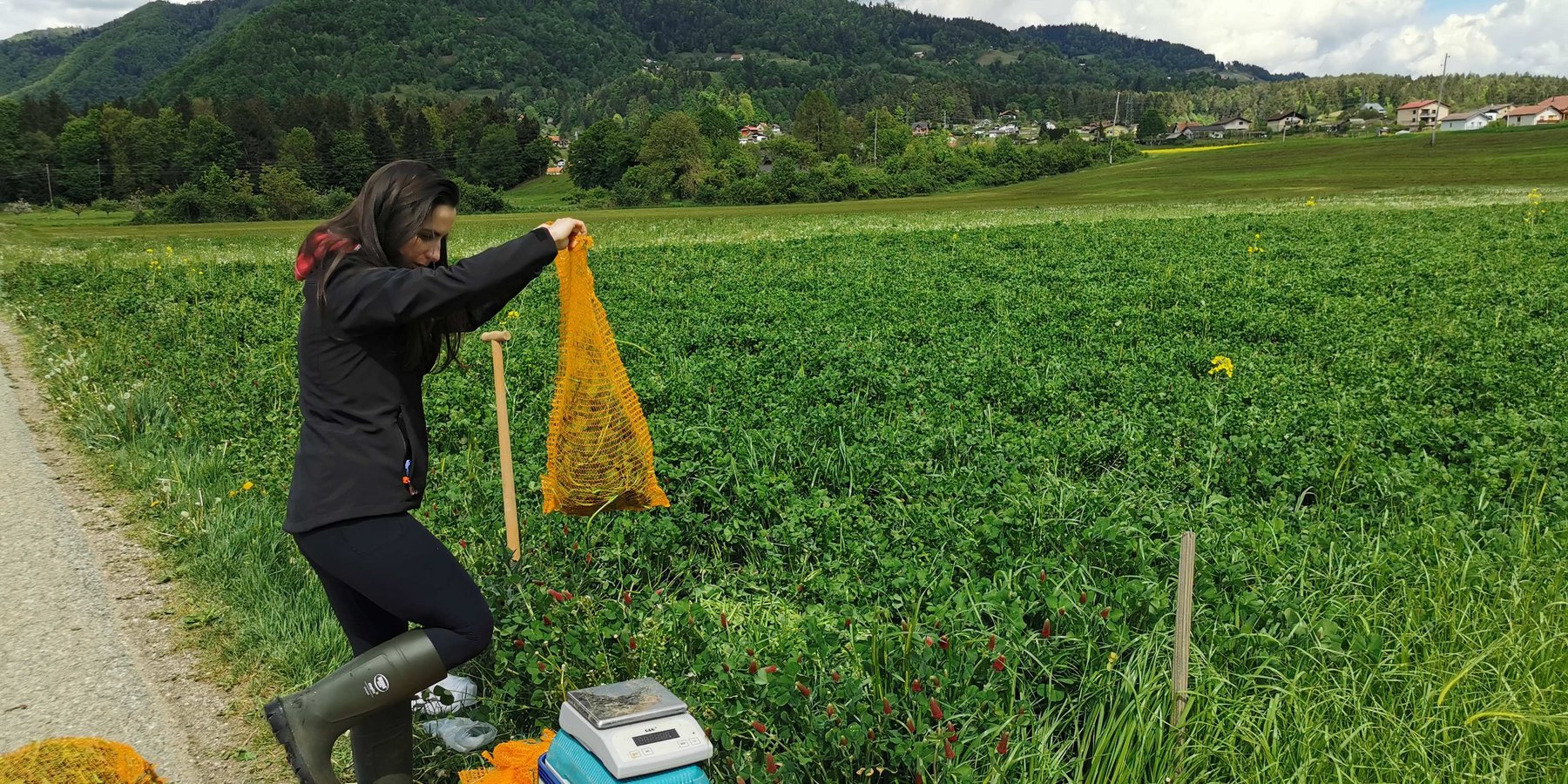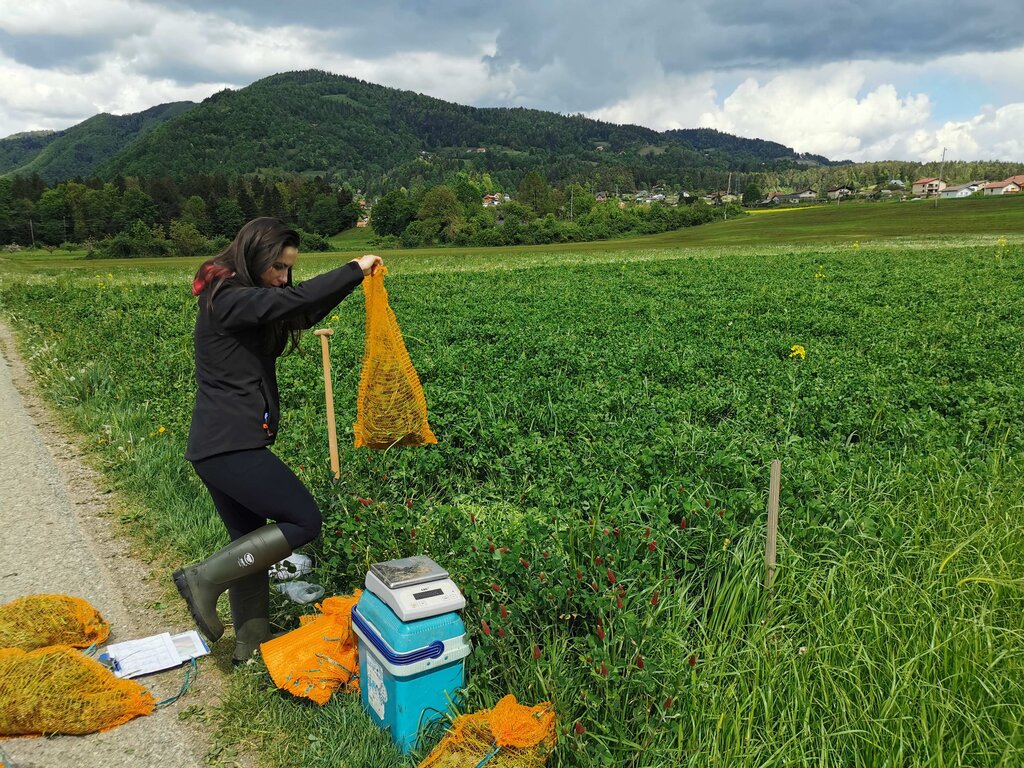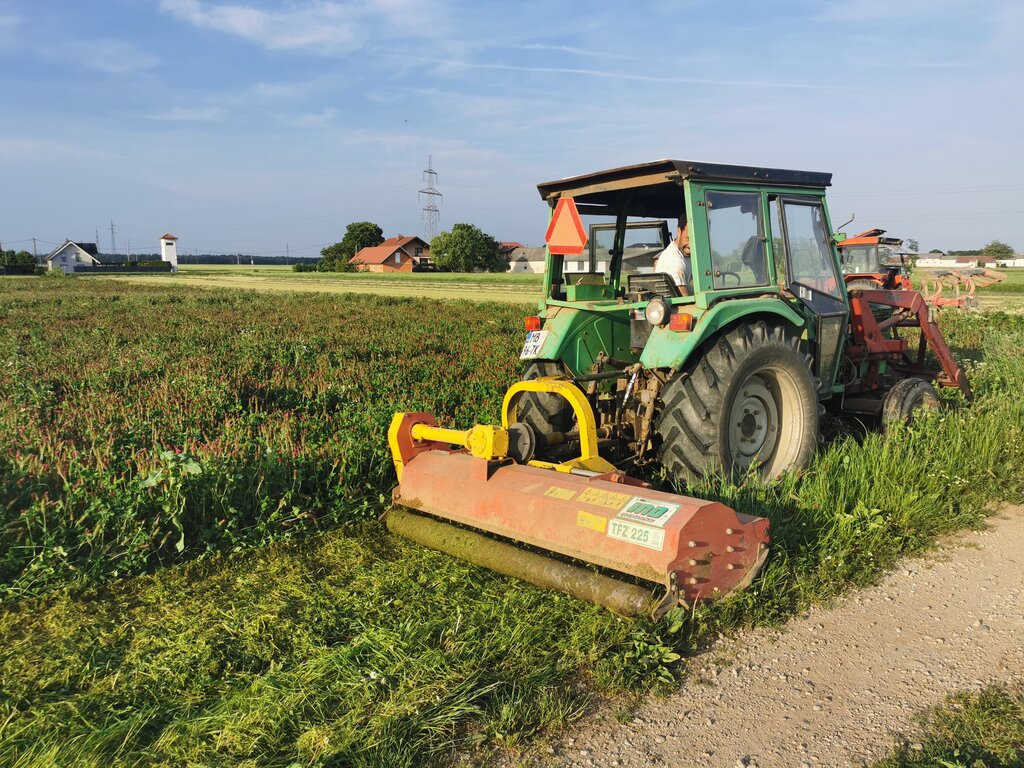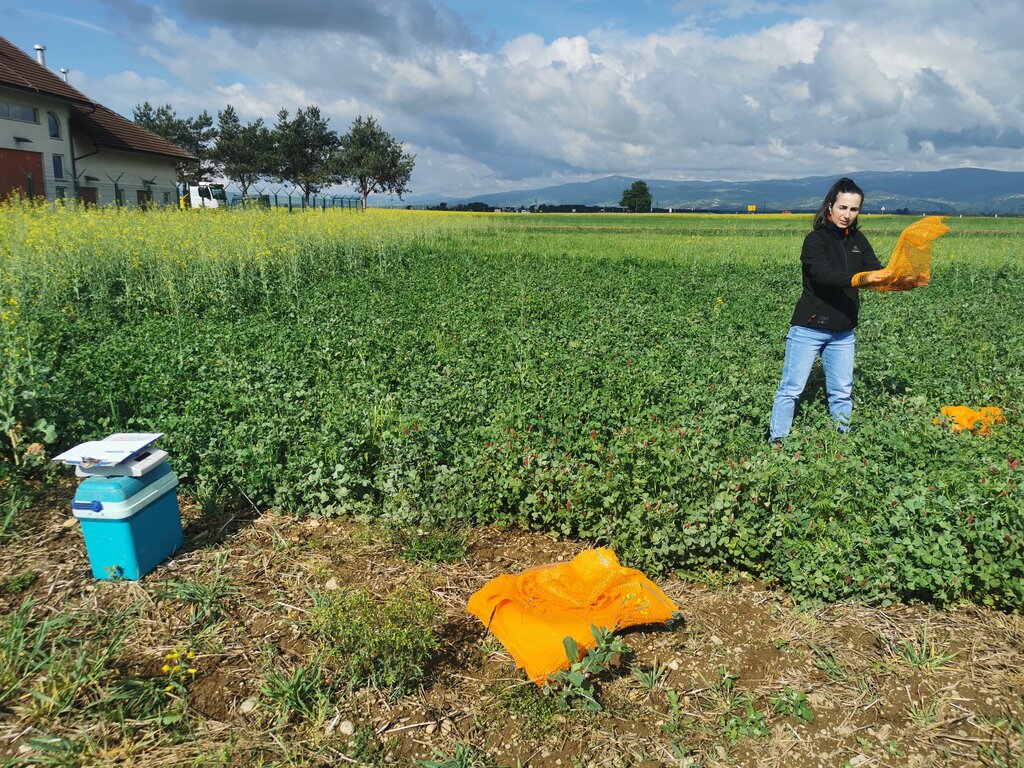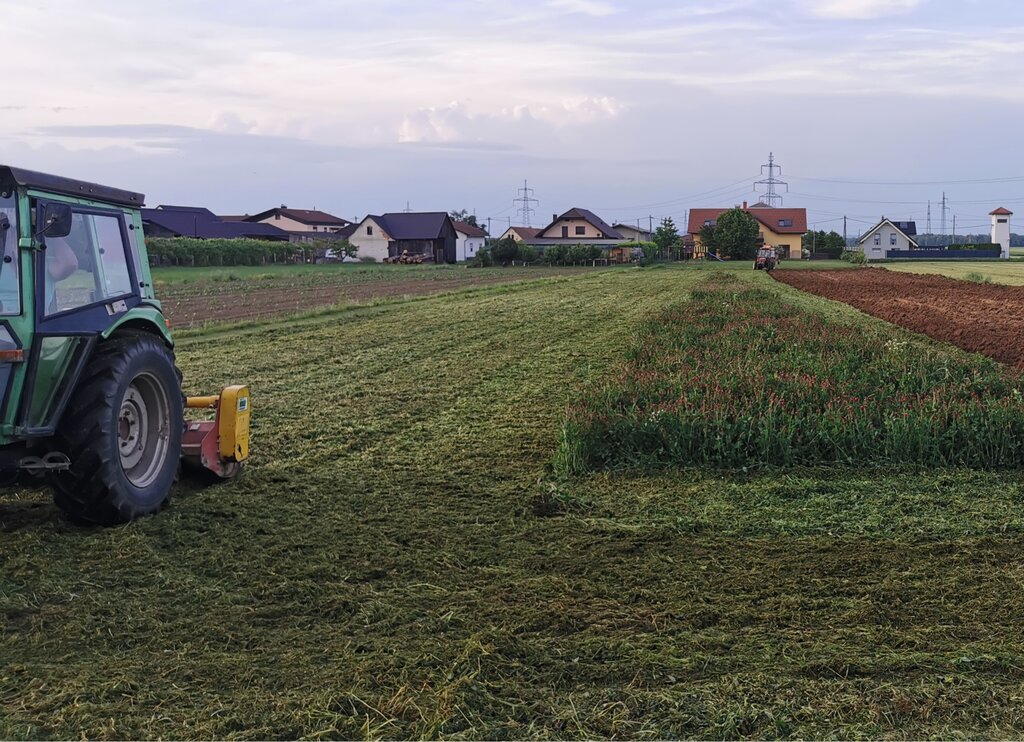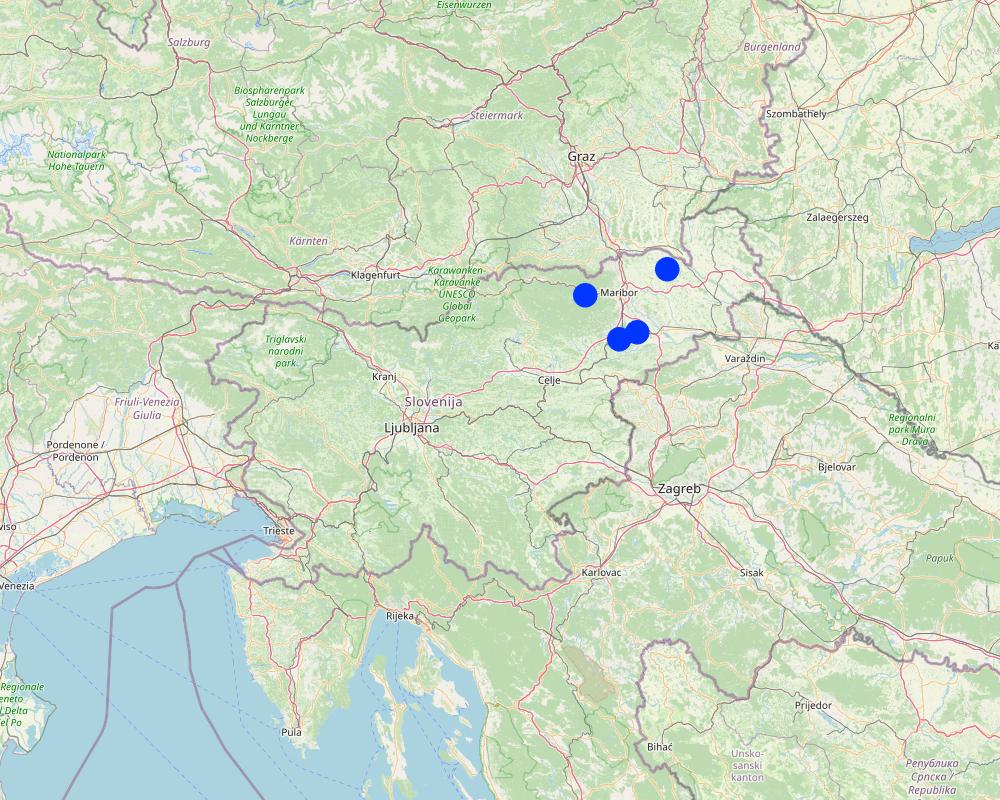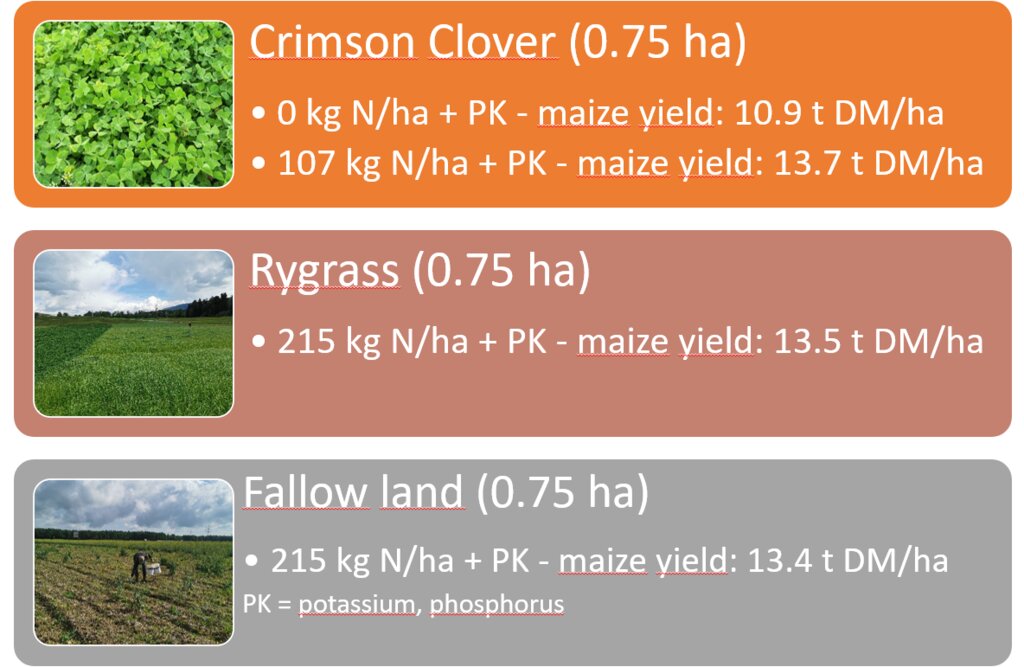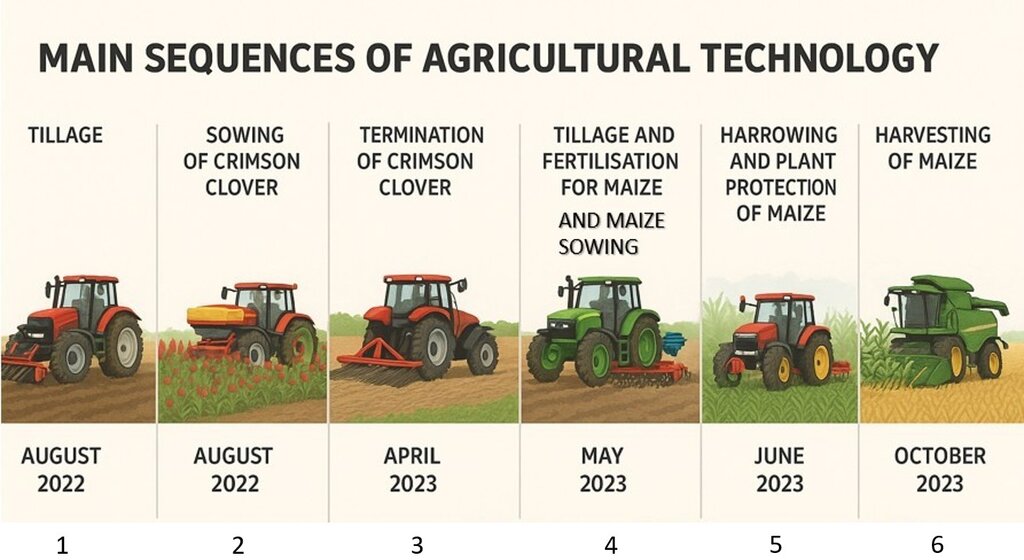Crimson clover as an overwintering cover crop for nitrogen supply [سلوفينيا]
- تاريخ الإنشاء:
- تحديث:
- جامع المعلومات: Tamara Korošec
- المحرر: Gregor Kramberger
- المراجعون: William Critchley, Rima Mekdaschi Studer
Inkarnatka kot prezimni dosevek za oskrbo z dušikom
technologies_7507 - سلوفينيا
عرض الأقسام
توسيع الكل طي الكل1. معلومات عامة
1.2 تفاصيل الاتصال بالأشخاص الرئيسيين لمصدر المعلومات والمؤسسات المشاركة في تقييم وتوثيق التقنية
اسم المشروع الذي سهّل توثيق/تقييم التقنية (إذا كان ذلك على صلة)
Integration of cover crops into field crop rotation - Slovenia (EIP-AGRI)اسم المؤسسة (المؤسسات) التي سهلت توثيق/تقييم التقنية (إذا كان ذلك على صلة)
Chamber of Agriculture and Forestry of Slovenia – Institute of Agriculture and Forestry Maribor (KGZS) - سلوفينيا1.3 الشروط المتعلقة باستخدام البيانات الموثقة من خلال WOCAT
يوافق جامع المعلومات والشخص (لاشخاص) الرئيسي لمصدر المعلومات على الشروط المتعلقة باستخدام البيانات الموثقة من خلال WOCAT:
نعم
1.4 إعلان بشأن استدامة التقنية الموصوفة
هل التقنية الموصوفة هنا تمثل مشكلة فيما يتعلق بتدهور الأراضي، بحيث لا يمكن إعلانها تقنية مستدامة لإدارة الأراضي؟:
كلا
2. وصف تقنيةالإدارة المستدامي للأراضي
2.1 وصف مختصر للتقنية
تعريف التقنية:
Crimson clover, overwintered as a cover crop, forms a symbiotic relationship with nitrogen-fixing bacteria, capturing nitrogen and thus enriching the soil. This helps reduce the need for synthetic fertilizers and aids in soil erosion control, weed suppression, and improved soil structure.
2.2 وصف تفصيلي للتقنية
الوصف:
Crimson clover (Trifolium incarnatum) is a winter annual legume used as a cover crop for nitrogen fixation, erosion control, and soil improvement. It is well suited to mild winter climates and can be integrated into various farming systems. It can be sown alone or in mixtures after the main crop is harvested. It covers the soil from late summer until spring and can be used as fodder or for green manure.
Its key function is nitrogen fixation through the help of nitrogen-fixing bacteria (Rhizobium). Through the winter it protects the soil from erosion, prevents nutrient leaching, and helps suppress weeds. The deep root system improves soil aeration and drainage. When terminated, it adds organic matter and nutrients to the soil, and its nectar-rich flowers attract pollinators and provide a habitat for beneficial predatory insects.
Crimson clover is often included in multi-year crop rotations. Activities include light tillage or no-till. Sowing usually takes place in late August to early September - or at least 6 to 8 weeks before the first frost. Fertilization with mineral nitrogen is not required, but phosphorus and potassium can help in establishment. Minimal maintenance is needed as these plants suppress weeds and reduce pests, but some fungal diseases may occur in wet conditions. Termination involves mowing or rolling at 50% bloom and then herbicides, or it can be incorporated as green manure.
Farmers value crimson clover for its multiple benefits including cost savings from reduced fertilizer use. Livestock farmers use it for forage. Some challenges may arise in colder climates, and when the soil is wet or compacted.
Under trials, the use of crimson clover as a cover crop to supply nitrogen was compared with a ryegrass cover crop and with fallow land, where no cover crops were used. The seeds were sown during two periods—early (August) and late (September)—and the cover crops were not further fertilized. The cover crops were terminated before sowing maize. The fallow area and the ryegrass area were fertilized according to the requirements of maize (215 kg N/ha) and soil analysis (for P and K). Half of the crimson clover area received no N fertilization, and the other half received only half of the required N. The maize crop was monitored by measuring soil, maize growth, grain yield, whole plant weight, and root weight. Crimson clover contributed between 61.6 and 78.6 kg of symbiotically fixed N ha⁻¹. The total soil amount of N accumulated by crimson clover was 100.7 kg N ha⁻¹, twice as much as under Italian ryegrass. The maize grain yields were significantly the lowest (10.9 t DM grain ha⁻¹) where crimson clover was sown early and the maize received no additional N. When crimson clover was used and maize was fertilized with half the N rate, grain yields were equivalent to those obtained on plots that received the full N rate (Italian ryegrass 13.5 t DM ha⁻¹, and the bare fallow control 13.4 t DM ha⁻¹).
2.3 صور التقنية
2.5 البلد/المنطقة/المواقع التي تم تنفيذ التقنية فيها والتي يغطيها هذا التقييم
البلد:
سلوفينيا
المنطقة/الولاية/المحافظة:
Podravje
مزيد من التفاصيل حول الموقع:
Selnica ob Dravi, Cirkovce, Pragersko
حدد انتشار التقنية:
- منتشرة بالتساوي على مساحة
إذا كانت المساحة الدقيقة غير معروفة، فيرجى الإشارة إلى المنطقة التقريبية المغطاة:
- < 0.1 كم2 (10 هكتار)
هل يقع موقع/مواقع التقنية في منطقة محمية بشكل دائم؟:
كلا
التعليقات:
The technology is spread throughout arable land in Slovenia. The trial was conducted only on six farms in Podravje region .
Map
×2.6 تاريخ التنفيذ
اذكر سنة التنفيذ:
2024
2.7 إدخال التقنية
حدد كيف تم إدخال التقنية:
- من خلال ابتكار مستخدمي الأراضي
- أثناء التجارب/الأبحاث
- من خلال المشاريع/ التدخلات الخارجية
التعليقات (نوع المشروع، الخ):
The European Innovation Partnership (EIP) projects for agricultural productivity and sustainability (EIP-AGRI) enable exchange of knowledge for agriculture, forestry, and rural areas. The technology was introduced on these farms through the EIP project: "Integration of Cover Crops in Crop Rotation – Possibilities for Replacing Nitrogen from Mineral Fertilizers in Fertilization of the Next Crop"
3. تصنيف تقنية الإدارة المستدامي للأراضي
3.1 الغرض الرئيسي ( الأغراض الرئيسية) للتقنية
- تحسين الإنتاج
- الحد من تدهور الأراضي ومنعه وعكسه
- الحفاظ على/تحسين التنوع البيولوجي
- التكيف مع تغير المناخ/الظواهر المتطرفة وآثارها
- خلق أثر اقتصادي مفيد
3.2 نوع (أنواع) استخدام الأراضي الحالية حيث يتم تطبيق التقنية
استخدامات الأراضي مختلطة ضمن نفس وحدة الأرض:
كلا
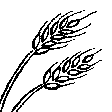
الأراضي الزراعية
- زراعة سنوية
الزراعة السنوية - حدد المحاصيل:
- الحبوب - الذرة
نظام زراعة سنوي:
الذرة/الذرة الرفيعة/الدخن من البقوليات
عدد مواسم الزراعة في السنة:
- 1
هل يتم ممارسة الزراعة البينية؟:
كلا
هل تتم ممارسة تناوب المحاصيل؟:
نعم
إذا كانت الإجابة بنعم، حدد:
5 year crop rotation: 3 different main crops in 5 years, plus cover crops after spring crops
3.3 هل تغير استخدام الأراضي نتيجة لتنفيذ التقنية؟
هل تغير استخدام الأراضي نتيجة لتنفيذ التقنية؟:
- لا (تابع مع السؤال 3.4)
3.4 إمدادات المياه
إمدادات المياه للأرض التي يتم تنفيذ التقنية عليها:
- بعلية
3.5 مجموعةالإدارة المستدامة للأراضي التي تنتمي إليها هذه التقنية
- تحسين الغطاء الأرضي/النباتي
- الإدارة المتكاملة لخصوبة التربة
3.6 التدابير التقنية في مجال إلادارة المستدامة للأراضي
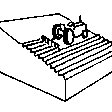
التدابير الزراعية
- A1: الغطاء النباتي/التربة
- A2: المادة العضوية/خصوبة التربة
3.7 الأنواع الرئيسية من تدهور الأراضي التي تناولتها التقنية
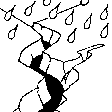
تآكل التربة بالمياه
- الوزن(Wt): فقدان التربة السطحية/تآكل السطح
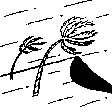
تآكل التربة الناتج عن الرياح
- (Et): فقدان التربة السطحية
التعليقات:
Although primary cause of technology is natural nitrogen supply, the technology indirectly addressed also the soul erosion.
3.8 منع أو حد أو عكس تدهور الأراضي
تحديد هدف التقنية فيما يتعلق بتدهور الأراضي:
- منع تدهور الأراضي
4. المواصفات الفنية، وأنشطة التنفيذ، والمدخلات، والتكاليف
4.1 الرسم الفني للتقنية
المواصفات الفنية (المتعلقة بالرسم الفني):
The technology of using crimson clover as a cover crop (variety 'Bolsena') to supply nitrogen was compared with the ryegrass cover crop (variety 'Turtetra') and fallow land, where no cover crops were used. Each plot covered area of 0.75 ha. The seeds were sown during two testing periods—early (August) and late (September)—and the cover crops were not further fertilized. The cover crops were terminated through mulching or ploughing before sowing the main crop, which was maize. The fallow area and the ryegrass area were fertilized according to the maize's requirements (215 kg N/ha) and soil analysis (phosphorus, P; potassium, K). Half of the area with crimson clover received no nitrogen fertilization, and the other half received only half of the required nitrogen (107 kg N/ha). The maize crop was monitored throughout the growing season by measuring soil nitrogen and assessing maize growth.
المؤلف:
Tamara Korošec
التاريخ:
03/03/2025
المواصفات الفنية (المتعلقة بالرسم الفني):
Main sequences of the technology: 1. tillage and seed bed preparation (disc cultivator or similar) for sowing cover crop (crimson clover) after the winter cereals harvest (August 2022); 2. sowing of crimson clover is usually combined with tillage, or done separately (August 2022); 3. mechanical termination of crimson clover (April 2023), 4. tillage, fertilisation, seed bed preparation and sowing of maize (may 2023), 5. harrowing and plant protection (herbicide) of maize (June 2023), 6. harvesting of maize (October 2023).
المؤلف:
Tamara Korošec (made with Chat GPT)
التاريخ:
30/09/2025
4.2 معلومات عامة بخصوص حساب المدخلات والتكاليف
حدد كيفية احتساب التكاليف والمدخلات:
- حسب مساحة تنفيذ التقنية
الإشارة إلى حجم ووحدة المساحة:
ha
عملة أخرى/ عملة وطنية (حدد):
EUR
إذا كان ذا صلة، وضح سعر الصرف من الدولار الأمريكي إلى العملة المحلية (على سبيل المثال، 1 دولار أمريكي = 79.9 ريال برازيلي): 1 دولار أمريكي =:
0,85
4.3 أنشطة التأسيس
التعليقات:
None
4.4 التكاليف والمدخلات اللازمة للتأسيس
التعليقات:
None
4.5 الصيانة/الأنشطة المتكررة
| النشاط | التوقيت/الوتيرة | |
|---|---|---|
| 1. | Stubble preparation (tillage) for crimson clover + sowing (stages 1 and 2 in diagram) | August (or September) |
| 2. | Mechanical cover crop termination and soil preparation before maize sowing (stage 3 in diagram) | end of April |
| 3. | Sowing of maize (stage 4 in diagram) | May |
| 4. | Fertilisation (part of stage 4 in diagram) | May, June |
| 5. | Hoeing and weed control (herbicide) (stage 5 in diagram) | May, June |
| 6. | Harvest (maize) (stage 6 in diagram) | October |
| 7. | Drying (maize) (part of stage 6 in diagram) | October |
4.6 التكاليف والمدخلات اللازمة للصيانة/للأنشطة المتكررة (سنويًا)
| تحديد المدخلات | الوحدة | الكمية | التكاليف لكل وحدة | إجمالي التكاليف لكل مدخل | % من التكاليف التي يتحملها مستخدمو الأراضي | |
|---|---|---|---|---|---|---|
| العمالة | All labour costs | hour | 6,0 | 15,0 | 90,0 | 100,0 |
| معدات | Stubble preparation for crimson clover (tillage) | ha | 1,0 | 50,0 | 50,0 | 100,0 |
| معدات | Sowing of crimson clover | ha | 1,0 | 46,3 | 46,3 | 100,0 |
| معدات | Mechanical termination of the crimson clover | ha | 1,0 | 37,5 | 37,5 | 100,0 |
| معدات | Tillage and seed bed preparation for maize | ha | 1,0 | 60,0 | 60,0 | 100,0 |
| معدات | Maize sowing | ha | 1,0 | 60,0 | 60,0 | 100,0 |
| معدات | Maize hoeing and weed control | ha | 1,0 | 60,0 | 60,0 | 100,0 |
| معدات | Maize harvesting | ha | 1,0 | 140,0 | 140,0 | 100,0 |
| المواد النباتية | Crimson clover seed | ha | 28,0 | 3,5 | 98,0 | 100,0 |
| المواد النباتية | Maize seed | ha | 1,0 | 290,0 | 290,0 | 100,0 |
| الأسمدة والمبيدات الحيوية | Fertilizer | ha | 1,0 | 150,0 | 150,0 | 100,0 |
| الأسمدة والمبيدات الحيوية | Herbicide | ha | 1,0 | 80,0 | 80,0 | 100,0 |
| غير ذلك | Drying of maize grain | all harvest | 1,0 | 428,0 | 428,0 | 100,0 |
| إجمالي تكاليف صيانة التقنية | 1589,8 | |||||
| إجمالي تكاليف صيانة التقنية بالدولار الأمريكي | 1870,35 | |||||
إذا لم تتمكن من تفصيل التكاليف في الجدول أعلاه، قدم تقديرًا للتكاليف الإجمالية لصيانة التقنية:
1561,8
التعليقات:
The above calculation is for combination of crimson clover cover crop and half the amount of nitrogen fertilizer (107 kg/ha) for maize production. This technology had similar grain production (13.7 t/ha) as full application of mineral nitrogen (215 kg/ha) with combination of fallow land or ryegrass as cover crop. The revenue for this technology from selling the grain was 2877 €/ha (0.21 €/kg). Crimson clover with no additional mineral fertilisation for maize had significantly lower yields (10.9 t/ha) and thus lower revenue per hectare (2289 €/ha; 0.21 €/kg of grain). For crops which need less nitrogen than corn, the additional mineral N fertilisation would not be necessary and so costs would be lower. Farmers get 180 € of basic subsidies per ha and further 148 € per ha for greening through the winter (EU CAP).
4.7 أهم العوامل المؤثرة على التكاليف
قدم وصفا لأهم العوامل التي تؤثر على التكاليف:
Most important factors affecting the costs are the price of seeds and machinery hours.
5. البيئة الطبيعية والبشرية
5.1 المناخ
هطول الأمطار السنوي
- < 250 مم
- 251- 500 ملم
- 501 - 750ملم
- 1,000-751 ملم
- 1,500-1,100 ملم
- 2,000-1,500 ملم
- 3,000-2,001 ملم
- 4,000-3,100 ملم
- > 4000 ملم
الإشارة إلى اسم محطة الأرصاد الجوية المرجعية المعنية:
ARSO - Environmental Agency of Republic of Slovenia, archive data (last 10 years) for main station in Podravje region - Letališče Edvarda Rusjana Maribor
المنطقة المناخية الزراعية
- شبه رطبة
Continental Climate (Central and Northeastern Slovenia). Meteo station Letališče Edvarada Rusjana Maribor:
Cold winters and hot summers. The average yearly temperature (last 10 years) is 11.5 degrees C.
Large temperature fluctuations between seasons. Average maximal temperature 16.7 degrees C. , the average minimal temperature is 6.4 degrees C. Absolute max. temperature (ave 10 years) was 34 degrees C, and the average absolute minimal temperature approximately -10 degrees.
5.2 طوبوغرافيا
متوسط الانحدارات:
- مسطح (0-2%)
- بسيط (3-5%)
- معتدل (6-10%)
- متدحرج (11-15%)
- تلال (16-30%)
- شديدة الانحدار(31-60%)
- فائقة الانحدار (>60%)
التضاريس:
- هضاب/سهول
- أثلام مرتفعة
- المنحدرات الجبلية
- منحدرات التلال
- منحدرات في السفوح
- قاع الوادي
المنطقة الارتفاعية:
- 100-0 متر فوق سطح البحر
- 500-101 متر فوق سطح البحر
- 1,000-501 متر فوق سطح البحر
- 1,500-1,001 متر فوق سطح البحر
- 2,000-1,501 متر فوق سطح البحر
- 2,500-2,100 متر فوق سطح البحر
- 3,000-2,501 متر فوق سطح البحر
- 4,000-3,001 متر فوق سطح البحر
- > 4000 متر فوق سطح البحر
وضح ما إذا كانت التقنية مطبقة على وجه التحديد في:
- غير ذات صلة
5.3 التربة
متوسط عمق التربة:
- ضحل جدًا (0-20 سم)
- ضحلة (21-50 سم)
- متوسطة العمق (51-80 سم)
- عميقة (81-120 سم)
- عميقة جدًا (> 120 سم)
قوام التربة (التربة السطحية):
- متوسط ( طميي، سلتي)
قوام التربة (> 20 سم تحت السطح):
- متوسط ( طميي، سلتي)
المواد العضوية في التربة السطحية:
- عالية (>3%)
إذا كان متاحًا، قم بإرفاق وصف كامل للتربة أو تحديد المعلومات المتوفرة، على سبيل المثال نوع التربة، الرقم الهيدروجيني/ درجة حموضة التربة، قدرة التبادل الكاتيوني، النيتروجين، الملوحة وما إلى ذلك.
The test fields were on different soil types:
- Eutric alluvial soils pH 6,6-7,2
- Dystric brown soils on non calcareous sandy gravel sediments, pH4,6-5,5
- Eutric brown soils on alluvial-colluvial sediments and deluvium, pH 5,6-6,5
5.4 توافر المياه ونوعيتها
منسوب المياه الجوفية:
50-5 م
توافر المياه السطحية:
جيد
نوعية المياه (غير المعالجة):
مياه الشرب سيئة (تتطلب معالجة)
تشير جودة المياه إلى:
المياه الجوفية
هل تعتبر ملوحة الماء مشكلة؟:
كلا
هل تحدث فيضانات في المنطقة؟:
كلا
تعليقات ومواصفات أخرى بشأن نوعية المياه وكميتها:
In Slovenia all drinking water is treated by chlorine. If we compare it to the rest of the world, we have good drinking water, but we never use it untreated.
5.5 التنوع البيولوجي
تنوع الأنواع:
- مرتفع
تنوع الموائل:
- متوسط
التعليقات والمواصفات الإضافية بشأن التنوع البيولوجي:
Under the cover crop area soil biodiversity is high. Regarding overall habitat, the test areas are in intensive agricultural areas, that is why the habitat biodiversity which is otherwise high in Slovenia, is rated as moderate.
5.6 خصائص مستخدمي الأراضي الذين يطبقون التقنية
مستقر أو مرتحل:
- غير المترحل
التوجه السوقي لنظام الإنتاج:
- مختلط (كفاف/ تجاري)
- تجاري/سوق
الدخل من خارج المزرعة:
- 10-50% من جميع الإيرادات
المستوى النسبي للثروة:
- متوسط
أفراداً أو مجموعات:
- فرد/أسرة معيشية
مستوى المكننة:
- ميكانيكية/ مزودة بمحرك
الجنس:
- رجال
عمر مستخدمي الأرضي:
- متوسط العمر
5.7 متوسط مساحة الأرض التي يستخدمها مستخدمو الأراضي الذين يطبقون التقنية
- < 0.5 هكتارا
- 0.5 - 1 هكتار
- 1 -2 هكتار
- 2 - 5 هكتار
- 5 - 15 هكتار
- 15 - 50 هكتار
- 50 - 100هكتار
- 500-100 هكتار
- 1,000-500 هكتار
- 10,000-1,000 هكتار
- > 10,000 هكتار
هل يعتبر هذا نطاقًا صغيرًا أو متوسطًا أو واسعا (في إشارة إلى السياق المحلي)؟:
- على نطاق متوسط
5.8 ملكية الأراضي، وحقوق استخدام الأراضي، وحقوق استخدام المياه
ملكية الارض:
- دولة
- فردية، يوجد سند ملكية
حقوق استخدام الأراضي:
- مؤجر
- فردي
حقوق استخدام المياه:
- مجتمعي (منظم)
- مؤجر
هل تعتمد حقوق استخدام الأراضي على نظام قانوني تقليدي؟:
كلا
حدد:
Land use rights in Slovenia are primarily based on modern statutory law, not traditional or customary law. The main frameworks are the Constitution of the Republic of Slovenia, the Law of Property Code (Stvarnopravni zakonik, SPZ), the Agricultural Land Act (Zakon o kmetijskih zemljiščih, ZKZ), and the Spatial Planning and Building Acts (Zakon o urejanju prostora, Gradbeni zakon, etc.).
5.9 الوصول إلى الخدمات والبنية التحتية
الصحة:
- ضعيف
- معتدل
- جيد
التعليم:
- ضعيف
- معتدل
- جيد
المساعدة التقنية:
- ضعيف
- معتدل
- جيد
العمل (على سبيل المثال خارج المزرعة):
- ضعيف
- معتدل
- جيد
الأسواق:
- ضعيف
- معتدل
- جيد
الطاقة:
- ضعيف
- معتدل
- جيد
الطرق والنقل:
- ضعيف
- معتدل
- جيد
مياه الشرب وخدمات الصرف الصحي:
- ضعيف
- معتدل
- جيد
الخدمات المالية:
- ضعيف
- معتدل
- جيد
6. الآثار والتصريحات الختامية
6.1 الآثار التي أظهرتها التقنية في الموقع
الآثار الاجتماعية والاقتصادية
الإنتاج
إنتاج المحاصيل
الكمية قبل الإدارة المستدامة للأراضي:
215 kg/ha mineral nitrogen for 13.4 t of maize grain
الكمية بعد الإدارة المستدامة للأراضي:
107 kg/ha mineral nitrogen for 13.7 t of maize grain
التعليقات/ حدد:
increased maize grain yields with less use of nitrogen fertiliser (positive impact)
الدخل والتكاليف
النفقات على المدخلات الزراعية
الكمية قبل الإدارة المستدامة للأراضي:
201 €
الكمية بعد الإدارة المستدامة للأراضي:
101 €
التعليقات/ حدد:
reduced expenses on mineral fertiliser for 100 kg of N per ha (positive impact)
الآثار الايكولوجية
دورة المياه / الجريان السطحي
كمية المياه
التعليقات/ حدد:
improved water retention, filtration, drainage (positive impact)
التربة
رطوبة التربة
التعليقات/ حدد:
water retention capacity improved (positive impact)
غطاء التربة
التعليقات/ حدد:
late summer to spring soil cover
تكون قشرة التربة السطحية/انسداد مسام التربة
التعليقات/ حدد:
lowered soil crusting, which is a positive impact
دورة المغذيات/إعادة الشحن
الكمية قبل الإدارة المستدامة للأراضي:
0
الكمية بعد الإدارة المستدامة للأراضي:
61-150 kg/ha
التعليقات/ حدد:
symbiotic nitrogen fixation with crimson clover 61 - 150 kg/ha N fixation (depending on the weather and soil conditions)
المادة العضوية في التربة/تحت الطبقة c
التعليقات/ حدد:
green manure from cover crops increases soil organic matter
التنوع البيولوجي: الغطاء النباتي، الحيوانات
الغطاء النباتي
التعليقات/ حدد:
diversified vegetation cover
تنوع الموائل
التعليقات/ حدد:
increased soil microbial community, diversified crop rotation, benefits for pollinators
الحد من مخاطر المناخ والكوارث
آثار الفيضانات
التعليقات/ حدد:
better drainage
آثار الجفاف
التعليقات/ حدد:
Lowered evaporation from soil, water retention capacity
آثار السيكلون والعواصف المطرية
التعليقات/ حدد:
protection against erosion due to heavy rain storms
حدد تقييم الآثار في الموقع (القياسات):
On-site impacts included direct field measurements and expert judgements/ predictions on the basis of data from this and previous experiments.
6.2 الآثار التي أظهرتها التقنية خارج الموقع
القدرة على التخفيف / الترشيح
التعليقات/ حدد:
green cover filters the nutrients that go to the groundwater
قيّم الآثار خارج الموقع (القياسات):
Off-site impacts are predicted by expert judgements/ predictions on the basis of data from this and previous experiments.
6.3 تعرض التقنية وحساسيتها لتغير المناخ التدريجي والظواهر المتطرفة/الكوارث المرتبطة بالمناخ (كما يراها مستخدمو الأراضي)
تغير مناخ تدريجي
تغير مناخ تدريجي
| الموسم | زيادة أو نقصان | كيف تتعامل التقنية مع ذلك؟ | |
|---|---|---|---|
| درجة الحرارة الموسمية | الصيف | زيادة | باعتدال |
| درجة الحرارة الموسمية | الشتاء | زيادة | جيدا |
| هطول الأمطار الموسمية | الصيف | انخفاض | ليس جيدا |
| هطول الأمطار الموسمية | الشتاء | انخفاض | باعتدال |
الظواهر المتطرفة / الكوارث المرتبطة بالمناخ
الكوارث الجوية
| كيف تتعامل التقنية مع ذلك؟ | |
|---|---|
| عاصفةبَرَد محلية | باعتدال |
الكوارث المناخية
| كيف تتعامل التقنية مع ذلك؟ | |
|---|---|
| موجة حر | ليس جيدا |
| جفاف | ليس جيدا |
الكوارث البيولوجية
| كيف تتعامل التقنية مع ذلك؟ | |
|---|---|
| الإصابة بالحشرات/الديدان | جيدا |
6.4 تحليل التكلفة والعائد
كيف تتم مقارنة العوائدمع كلفة الصيانة/التكاليف المتكررة (من وجهة نظر مستخدمي الأراضي)؟
عوائد قصيرة الأجل:
محايد/متوازن
عوائد طويلة الأجل:
إيجابي
6.5 اعتماد التقنية
- 1-10%
من بين جميع الذين تبنوا التقنية، كم عدد الذين فعلوا ذلك بشكل تلقائي، أي دون تلقي أي حوافز مادية/مدفوعات؟:
- 10-0%
التعليقات:
They are mostly motivated by subsidies, so spontaneous adoption is a small percentage.
6.6 التكيف
هل تم تعديل التقنية مؤخرًا لتتكيف مع الظروف المتغيرة؟:
كلا
6.7 نقاط القوة / المزايا / الفرص التي توفرها التقنية
| نقاط القوة/ المزايا/ الفرص من وجهة نظر مستخدمي الأراضي |
|---|
| Lower costs for mineral fertilizers, subsidies for seeds |
| Good for soil health |
| Good for water absorption |
| نقاط القوة/ المزايا/ الفرص من وجهة نظر جامع المعلومات أو غيره من الاشخاص الرئيسيين لمصدر المعلومات |
|---|
| Climate change adaptation |
| Soil improvement - increase in organic matter, soil biodiversity, water capacity |
| Fixation of nitrogen form air, less mineral fertilisers |
6.8 نقاط ضعف / مساوىء / مخاطر التقنية وسبل التغلب عليها
| نقاط الضعف/ المساوىء/ المخاطر من وجهة نظر مستخدم الأراضي | كيف يمكن التغلب عليها؟ |
|---|---|
| Drought during the seeding of catch crop | earlier or later sowing - however it has an impact anyway |
| Additional work (compared to bare fallow) | combined machinery (soil preparation + sowing combined) |
| Risk of frost if the crimson clover is too big going into winter | sowing and mulching at right time |
| نقاط الضعف/ المساوىء/ المخاطر من وجهة نظر جامع المعلومات أو غيره من الاشخاص الرئيسيين لمصدر المعلومات | كيف يمكن التغلب عليها؟ |
|---|---|
| Not applicable for all main crops - early spring crops do not get the same benefits as late spring/summer crops | for early spring crops other nitrogen fixings plants can be used. |
| Nitrogen runoff if no main crop follows after crimson clover destruction | always plant main crop right away |
7. المراجع والروابط
7.1 طرق جمع/مصادر المعلومات
- زيارات ميدانية، مسوحات ميدانية
regular field visits and monitoring on 4 farms / fileds
- مقابلات مع مستخدمي الأراضي
4 farmers
- مقابلات مع المتخصصين/الخبراء في الإدارة المستدامة للأراضي
consultation with colleagues from the Life science faculty (2)
- التجميع من التقارير والوثائق الأخرى الموجودة
previously prepared reports form the EIP project
التعليقات:
The project was carried out for 2 years. The data were compiled during the whole time - regular monitoring, interviews, sampling...
7.2 المراجع للمنشورات المتاحة
العنوان، المؤلف، السنة، النظام القياسي الدولي لترقيم الكتب ISBN:
GSELMAN, Anastazija, LISEC, Urška, KOROŠEC, Tamara, PODVRŠNIK, Miran. S prezimnimi metuljnicami do nadomeščanja dušika iz mineralnih gnojil = Winter legumes as a substitute for nitrogen from mineral fertilisers. V: ČEH, Tatjana (ur.), KAPUN, Stanko (ur.). 32. mednarodno znanstveno posvetovanje o prehrani domačih živali [tudi] Zadravčevi-Erjavčevi dnevi 2024 = 32nd International Scientific Symposium on Nutrition of Farm Animals [being] Zadravec-Erjavec Days 2024 : zbornik predavanj = proceedings : Murska Sobota, 14. in 15. november 2024, 14th and 15th November 2024. Murska Sobota: Kmetijsko gozdarska zbornica Slovenije, Kmetijsko gozdarski zavod, 2024. Str. 61-66, graf. prikazi. ISBN 978-961-96187-7-6. [COBISS.SI-ID 215866371]
متاح من أين؟كم التكلفة؟:
in various Slovenian libraries - in Slovene
7.3 روابط للمعلومات ذات الصلة على الإنترنت
العنوان/الوصف:
Website
عنوان الرابط URL:
https://dosevki.um.si/
7.4 تعليقات عامة
Just a remark on question formulation: the instructions in section 6.1 appear a bit ambiguous when the response scale for some specific questions appears "reversed" in relation to the guideline parameter - such as "soil crusting" where a negative value is in fact a positive outcome.
الروابط والوحدات المواضيعية
توسيع الكل طي الكلالروابط
لا يوجد روابط
الوحدات المواضيعية
لا يوجد وحدات مواضيعية


